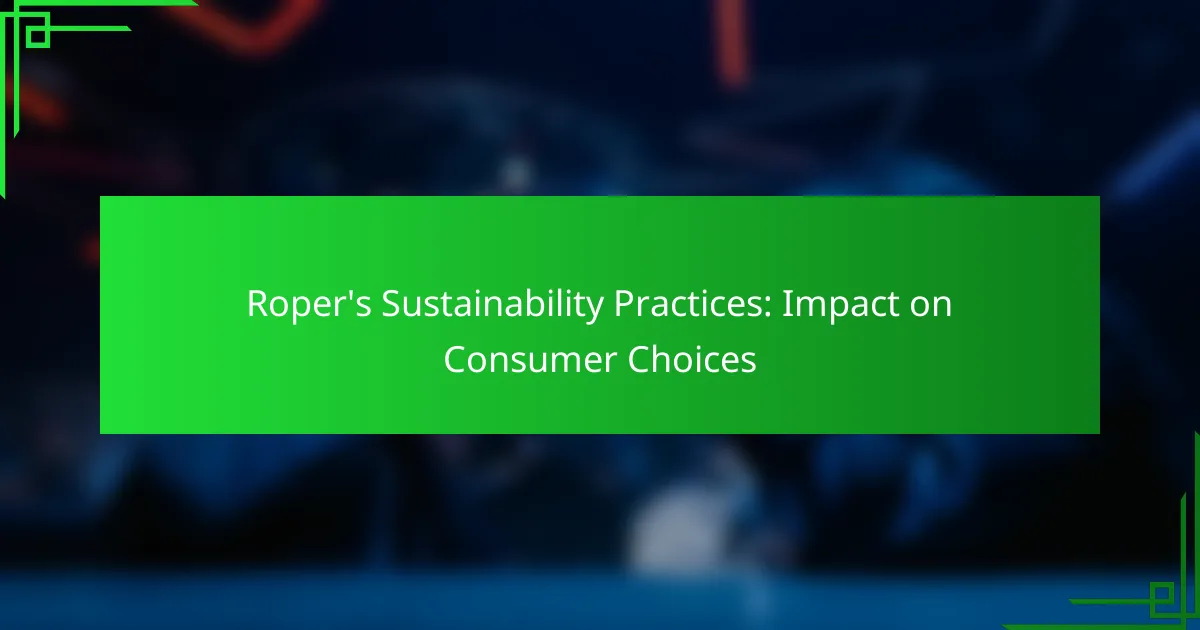Roper’s sustainability practices play a crucial role in shaping consumer choices by building trust and resonating with the values of eco-conscious shoppers. As awareness of environmental issues grows, consumers increasingly favor brands that prioritize sustainability through initiatives like using renewable materials and reducing carbon emissions. By transparently communicating these efforts, Roper not only informs its audience but also fosters responsible consumer behavior.

How do Roper’s sustainability practices influence consumer choices?
Roper’s sustainability practices significantly impact consumer choices by fostering trust and aligning with the values of environmentally conscious shoppers. As consumers become more aware of environmental issues, they increasingly seek brands that demonstrate a commitment to sustainability.
Increased brand loyalty
Roper’s dedication to sustainability cultivates increased brand loyalty among consumers. When customers perceive a brand as environmentally responsible, they are more likely to remain loyal, often choosing it over competitors. This loyalty can translate into repeat purchases and positive word-of-mouth recommendations.
For example, a study found that brands with strong sustainability practices can see loyalty rates increase by significant margins, often in the range of 20-30%. This loyalty is particularly strong among younger consumers who prioritize sustainability in their purchasing decisions.
Preference for eco-friendly products
Consumers are increasingly showing a preference for eco-friendly products, which Roper actively promotes through its sustainable practices. This shift is evident as shoppers look for items made from recycled materials or produced with minimal environmental impact. Roper’s commitment to sustainability positions its products favorably in this growing market segment.
In many cases, consumers are willing to pay a premium for eco-friendly options, with price differences typically ranging from 5-15%. This willingness indicates a strong market trend towards sustainability, making it essential for brands like Roper to continue innovating in this area.
Impact on purchasing decisions
Roper’s sustainability practices directly influence purchasing decisions by providing consumers with clear, actionable information about the environmental impact of their choices. Shoppers are more likely to support brands that transparently communicate their sustainability efforts, such as reducing carbon footprints or using sustainable sourcing.
To capitalize on this trend, Roper can enhance its marketing strategies by highlighting certifications, such as Fair Trade or organic labels, which resonate with eco-conscious consumers. Additionally, offering educational content about the benefits of sustainable products can further guide purchasing decisions, making it easier for consumers to choose Roper over less sustainable alternatives.
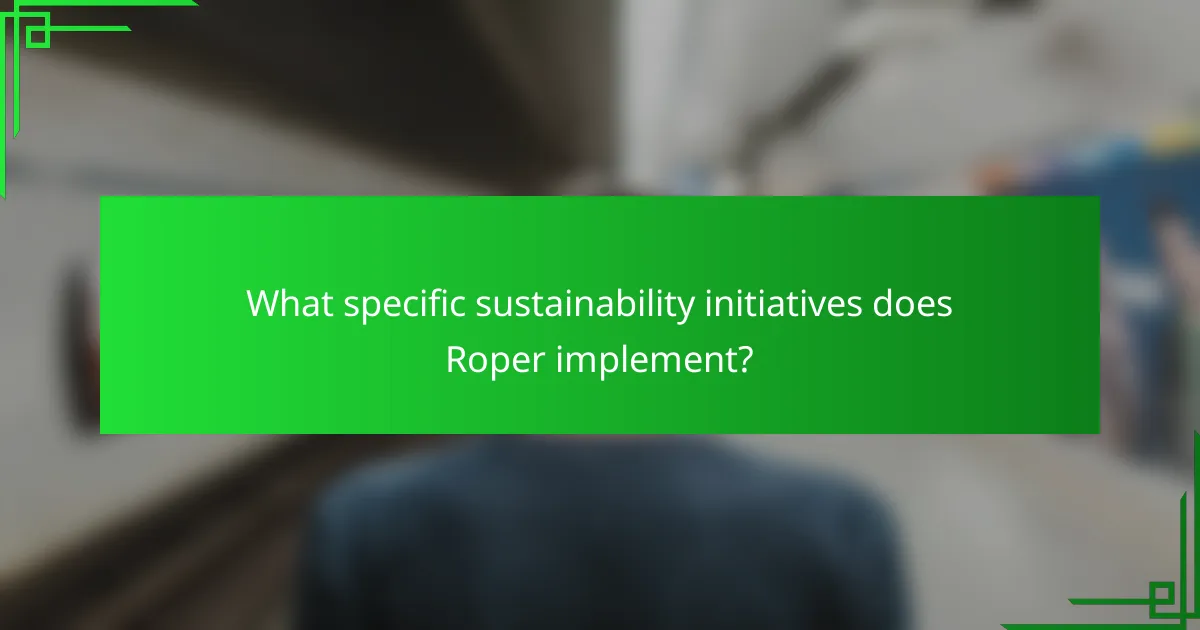
What specific sustainability initiatives does Roper implement?
Roper implements various sustainability initiatives aimed at minimizing environmental impact and promoting responsible consumer choices. These initiatives focus on using renewable materials, reducing carbon emissions, and managing waste effectively.
Use of renewable materials
Roper prioritizes the use of renewable materials in its products, which helps reduce reliance on finite resources. This includes sourcing biodegradable and recycled materials, which can significantly lower the environmental footprint of production.
For example, Roper may use organic cotton or recycled plastics in their manufacturing processes. This not only supports sustainable agriculture and recycling efforts but also appeals to environmentally conscious consumers.
Reduction of carbon footprint
To reduce its carbon footprint, Roper implements energy-efficient practices across its operations. This includes optimizing production processes and investing in renewable energy sources such as solar or wind power.
By adopting these measures, Roper aims to cut greenhouse gas emissions by a significant percentage, contributing to global efforts against climate change. Consumers are increasingly drawn to brands that demonstrate a commitment to sustainability through tangible actions.
Waste management strategies
Roper employs comprehensive waste management strategies to minimize waste generation and promote recycling. This involves conducting regular audits to identify areas for improvement and implementing practices that reduce waste at the source.
Additionally, Roper collaborates with recycling partners to ensure that materials are repurposed effectively. By focusing on waste reduction, Roper not only enhances its sustainability profile but also appeals to consumers who prioritize responsible consumption.
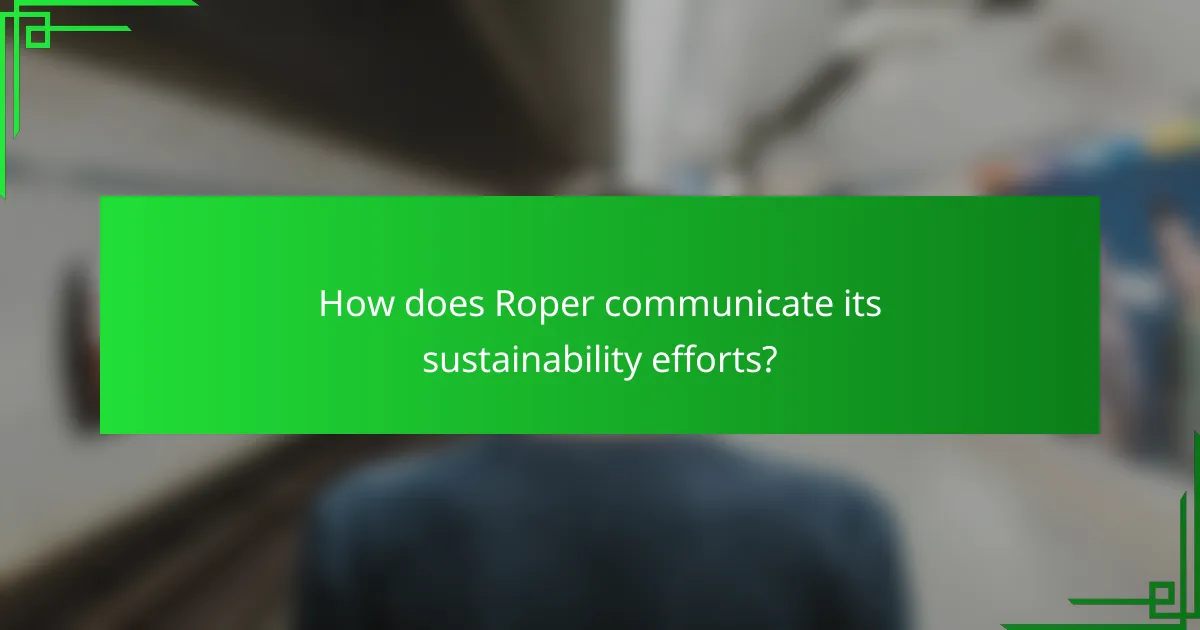
How does Roper communicate its sustainability efforts?
Roper effectively communicates its sustainability efforts through a combination of transparency in reporting and targeted marketing of eco-friendly initiatives. This approach not only informs consumers but also builds trust and encourages environmentally conscious choices.
Transparency in reporting
Roper prioritizes transparency by regularly publishing sustainability reports that detail their environmental impact, goals, and progress. These reports often align with recognized standards such as the Global Reporting Initiative (GRI), making it easier for consumers to understand their commitments.
By providing clear metrics on energy usage, waste reduction, and resource management, Roper allows consumers to assess their sustainability performance. This transparency fosters accountability and encourages consumers to support brands that align with their values.
Marketing eco-friendly initiatives
Roper actively markets its eco-friendly initiatives through various channels, including social media, advertising, and product packaging. Highlighting sustainable practices, such as using recycled materials or reducing carbon emissions, resonates with environmentally conscious consumers.
Promotional campaigns often feature certifications or eco-labels that validate Roper’s sustainability claims. By showcasing these initiatives, Roper not only enhances brand loyalty but also influences consumer choices toward more sustainable products.
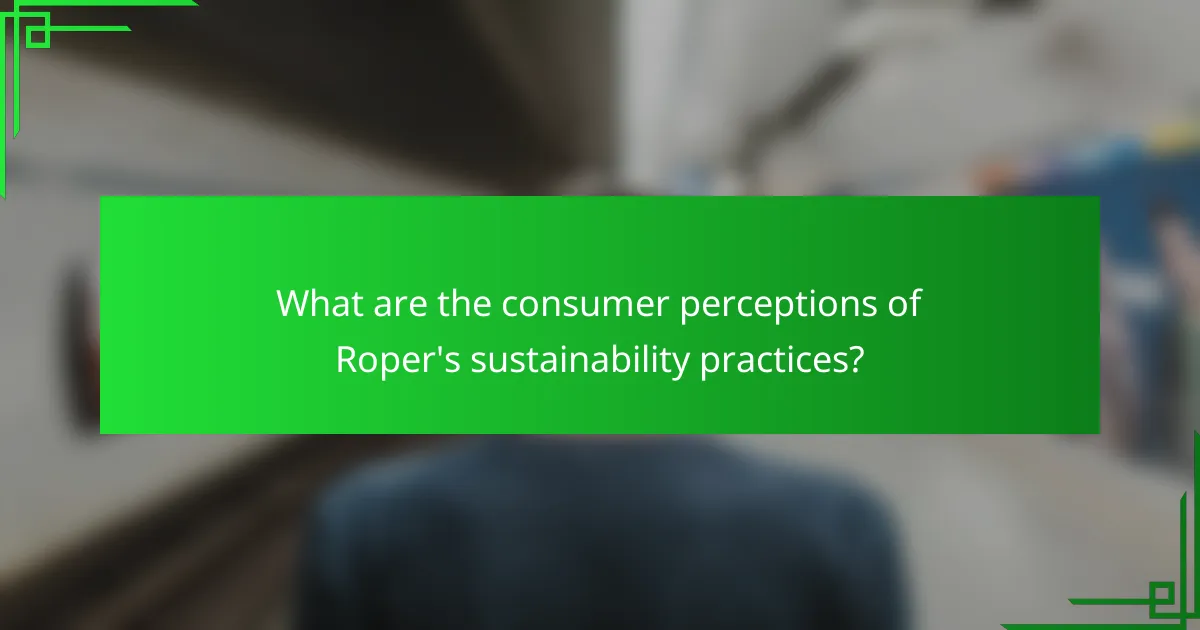
What are the consumer perceptions of Roper’s sustainability practices?
Consumers generally view Roper’s sustainability practices positively, associating them with environmental responsibility and ethical production. This perception influences their purchasing decisions, as many prefer brands that prioritize sustainability.
Positive brand image
Roper’s commitment to sustainability enhances its brand image, making it more appealing to environmentally conscious consumers. By adopting eco-friendly practices, such as using sustainable materials and reducing waste, Roper positions itself as a leader in responsible manufacturing.
A strong brand image rooted in sustainability can lead to increased customer loyalty. Consumers are more likely to support brands that align with their values, which can translate into repeat purchases and positive word-of-mouth recommendations.
Consumer trust and engagement
Roper’s sustainability initiatives foster trust among consumers, as transparency in practices builds credibility. When customers see genuine efforts towards sustainability, they are more likely to engage with the brand and feel confident in their purchasing choices.
Engagement can be further enhanced through effective communication of sustainability efforts. Roper can utilize social media, newsletters, and product labeling to inform consumers about its practices, creating a community of informed and loyal customers who advocate for the brand.

How do Roper’s practices compare to competitors?
Roper’s sustainability practices stand out against competitors by integrating eco-friendly initiatives that resonate with consumer values. Their commitment to reducing environmental impact and enhancing social responsibility influences consumer choices significantly.
Benchmarking against industry leaders
Roper’s sustainability efforts can be benchmarked against industry leaders such as Unilever and Patagonia, known for their comprehensive environmental strategies. While Unilever focuses on sustainable sourcing and reducing plastic waste, Patagonia emphasizes transparency and ethical production. Roper adopts similar practices but tailors them to its specific product lines, ensuring relevance to its consumer base.
For instance, Roper has implemented energy-efficient manufacturing processes, which aligns with the broader industry trend of reducing carbon footprints. This positions Roper favorably in the eyes of environmentally conscious consumers who prioritize brands with a clear sustainability agenda.
Unique selling propositions
Roper’s unique selling propositions include its commitment to using renewable materials and its transparent supply chain practices. These features appeal to consumers who are increasingly aware of the environmental and social implications of their purchases. By highlighting these aspects in marketing, Roper differentiates itself from competitors who may not emphasize sustainability as strongly.
Additionally, Roper engages in community initiatives that promote sustainability, such as local recycling programs and educational campaigns. This not only enhances their brand image but also fosters loyalty among consumers who value corporate social responsibility. By aligning their practices with consumer expectations, Roper effectively influences purchasing decisions in a competitive market.
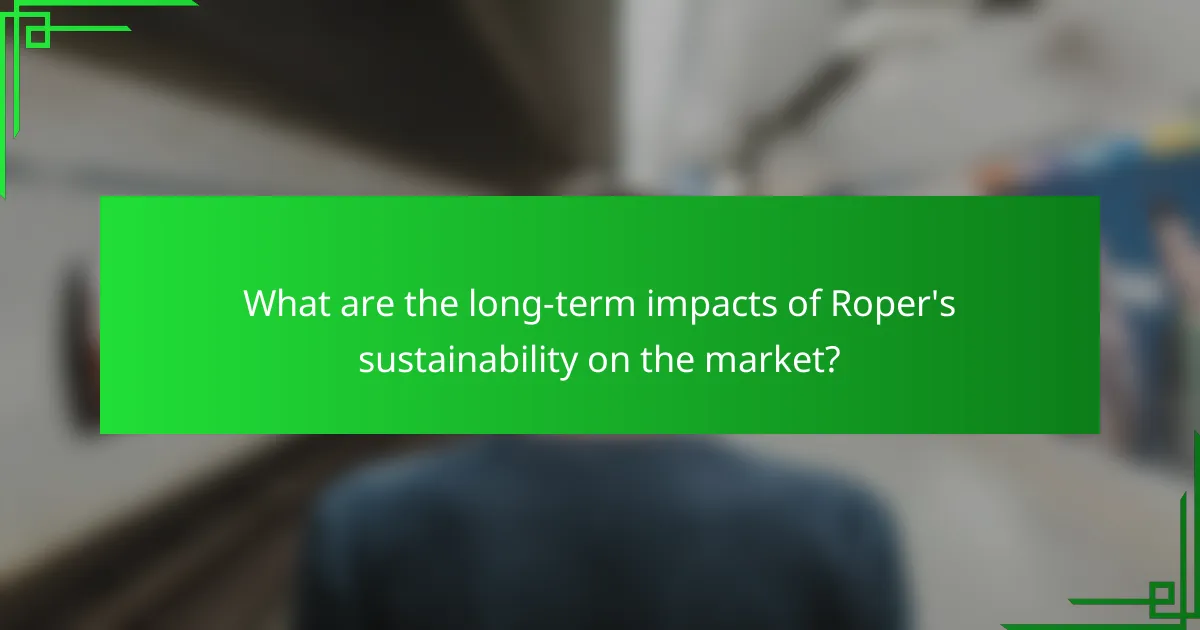
What are the long-term impacts of Roper’s sustainability on the market?
Roper’s commitment to sustainability significantly influences market dynamics by reshaping consumer preferences and driving demand for eco-friendly products. This shift not only enhances brand loyalty but also encourages other companies to adopt similar practices, ultimately fostering a more sustainable marketplace.
Shifts in consumer behavior
As consumers become more environmentally conscious, their purchasing decisions increasingly reflect their values. Many shoppers now prioritize brands that demonstrate a commitment to sustainability, often willing to pay a premium for eco-friendly products. This trend is particularly evident among younger demographics, who are more likely to support brands that align with their ethical beliefs.
Roper’s sustainability initiatives have led to a noticeable shift in consumer behavior, with many individuals actively seeking out products that are responsibly sourced and produced. This has resulted in a growing market segment for sustainable goods, encouraging brands to innovate and improve their environmental practices.
Emerging trends in sustainable e-commerce
The rise of sustainable e-commerce is transforming how consumers shop online. More platforms are now dedicated to offering eco-friendly products, making it easier for consumers to find and purchase sustainable options. This trend is supported by the increasing availability of information regarding product sustainability, allowing consumers to make informed choices.
Additionally, many online retailers are adopting sustainable practices in their operations, such as using eco-friendly packaging and implementing carbon-neutral shipping options. These initiatives not only appeal to environmentally conscious consumers but also enhance brand reputation and customer loyalty in a competitive market.
